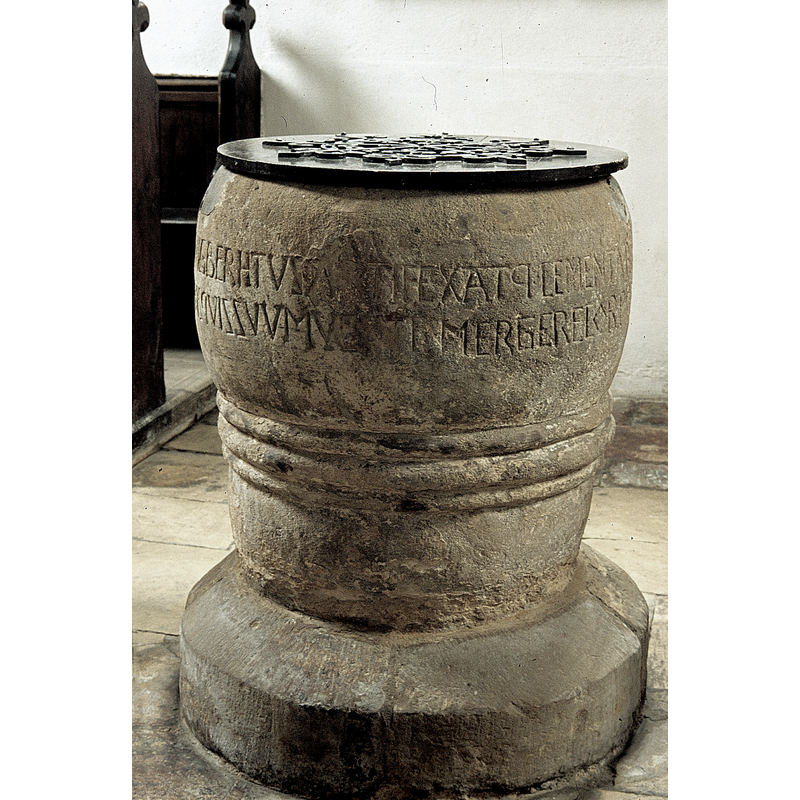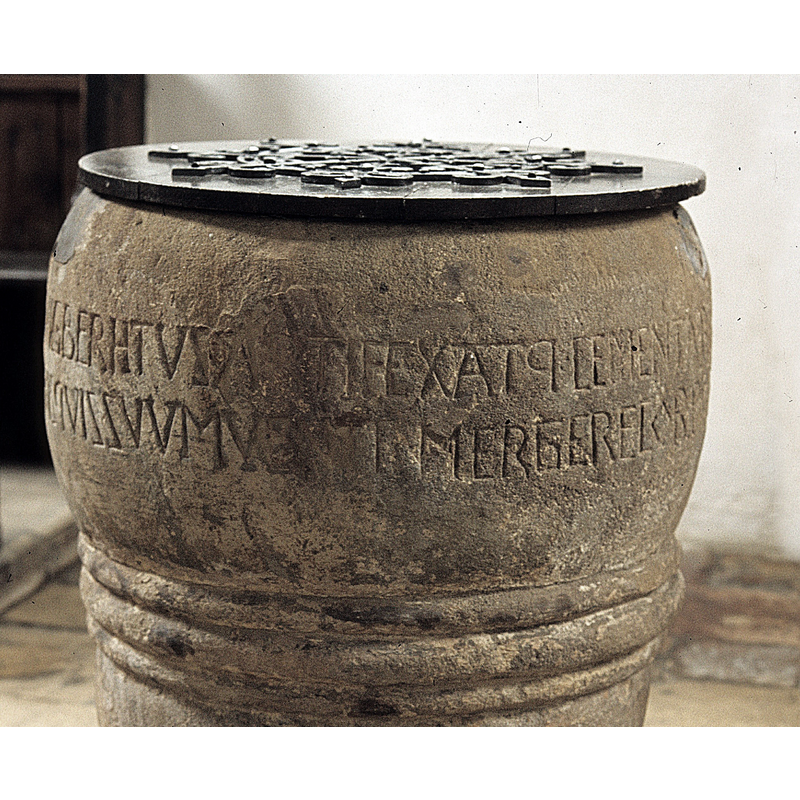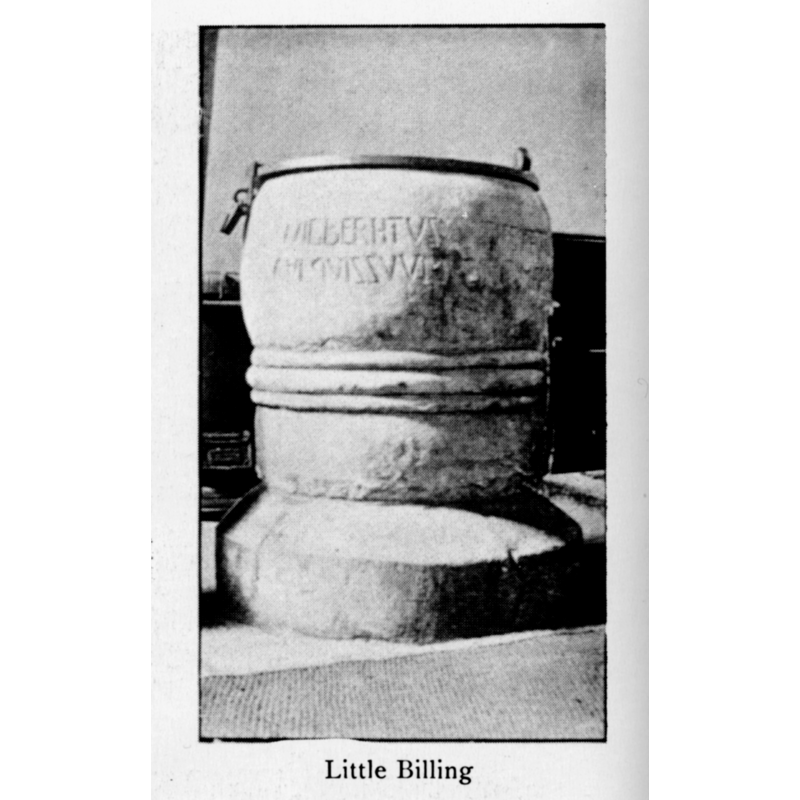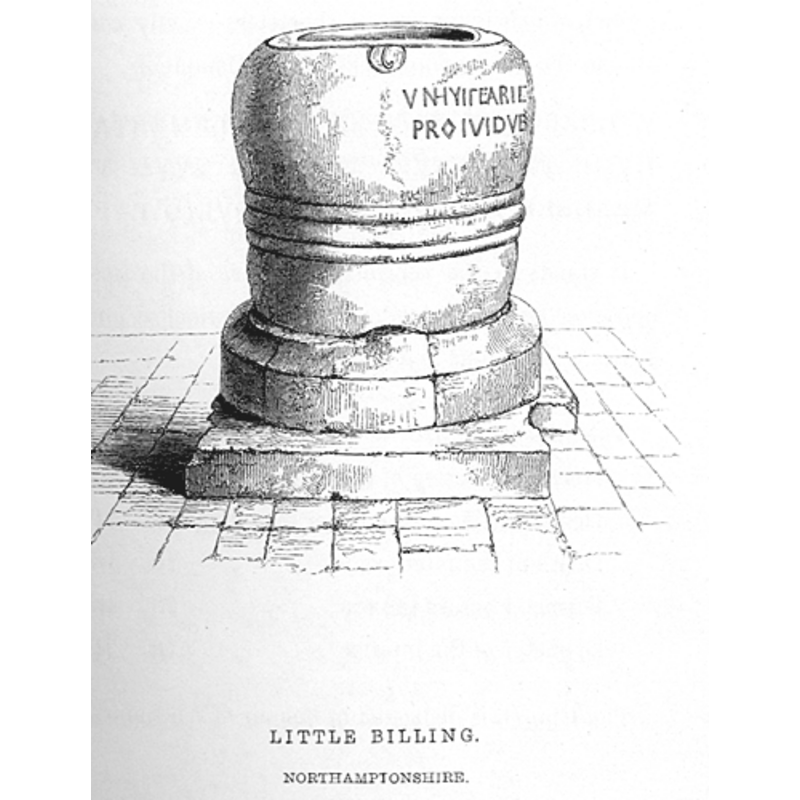Little Billing / Belinge / Bellica / Bellinge / Billinge / Billing Parva

Image copyright © Timothy Marlow, 2014
Image and permission received (letter of 26 October 2013)
Results: 13 records
design element - motifs - roll moulding - 3
information
inscription
inscription
inscription
inscription
view of font
view of font
view of font
Copyright Statement: Image copyright © Northamptonshire County Council, 2009
Image Source: digital image in VADS of a painting by J.L. Carr, from the J.L. Carr Collection in the Northamptonshire County Records Office [www.vads.ahds.ac.uk] [accessed 24 April 2009]
Copyright Instructions: PERMISSION NOT AVAILABLE -- IMAGE NOT FOR PUBLIC USE
view of font - east side
view of font and cover
view of font and cover
INFORMATION
FontID: 01086LIT
Object Type: Baptismal Font1
Church/Chapel: Parish Church of All Saints
Church Patron Saints: All Saints
Church Location: Church Lane, Little Billing, Northampton, Northamptonshire, NN3 9AF
Country Name: England
Location: Northamptonshire, East Midlands
Directions to Site: Located on the A45, in the E suburbs of Northampton
Ecclesiastic Region: Diocese of Peterborough [formerly in the diocese of Lincoln]
Historical Region: Hundred of Spelhoe
Font Location in Church: Inside the church, W end, centre of the nave
Century and Period: 10th - 12th century, Pre-Conquest? / Norman?
Cognate Fonts: Stretton Sugwas, East Challow, Poltimore
Font Notes:
Click to view
There are four entries for [Great and Little] Billing [variant spelling] in the Domesday survey [http://domesdaymap.co.uk/place/XX0000/great-and-little-billing/] [accessed 9 November 2014], one of which, the part in the lordship of Gunfrid of Chocques, mentions a priest in it, not a church, though there probably was one here. Barrel-shaped Saxon font. Paley (1844) calls it "jar-like" and dates the inscription to the time of William the Conqueror-- dated to the end of the 11th or begining of the 12th century [cf. the CRSBI entry below for a note on the inscription]. In Batty (1848), Parker (1849) and Whellan (1849) with reference to Paley. Bloxam (1858) has it as Norman. Romilly Allen (1888) states that the inscription is "in Latin capitals similar to those on the seal of William the Conqueror", and suggests a date "not later that the end of the eleventh century" based on the palaeographical and other evidence from the font. The only apparent ornament besides the inscription is the three plain bulging ring mouldings towards the bottom half of the barrel; inscribed in Latin (Anglo-Saxon lettering). Cox & Harvey (1907) give the following translation of the inscription: " Wigbert the artificer and mason made this [font], Whoever comes hither to dip his body, let him take it (Baptism) without doubt". Bond (1908) notes an "unfinished Latin inscription in characters exactly conforming with those on the great seal of William the Conqueror; it is to the following effect: 'Wilbert, craftsman and mason (artifex et cementarius), wrought this. Whoever comes to immerse his body without doubt gains.'" Bond (ibid.) dates the font to the end of the 11th or beginning of the 12th "on account of the palæological peculiarities of the inscriptions". Described in Tyrrell-Green (1928), who gives the inscription text as: "WILBERTUS ARTIFEX ATQ-CEMENTARIUS HUNC FABRICAVIT QUISQUIS SUUM VENIT MERGERE CORPUS PROCUL DUBIO CAPIT", which he translates as: "Wilbert craftsman and mason made this. Whoso cometh to immerse his body without doubt is the gainer". The Victoria County History (Northampton, vol. 4, 1937) notes: "On account of the palaeological peculiarity of its inscription, as well as from its resemblance to a Saxon baluster shaft, the font is generally attributed to the pre-Conquest period, but is probably not earlier than the 11th century". Mee (1945) writes: "a font shaped by a Saxon probably soon after England became Norman. It is crudely shaped like a barrel, and has round it an unfinished Latin inscription in plain characters still fine and easy to read, similar to those on the great seal of the Conqueror [...] The inscription reads: 'Wighbert the craftsman and mason made this. / Whoever comes to dip his body without doubt gains.' Although these long years the old font has been serving our people in our ancient countryside, and when the 13th century came it was fitted with a lock and staple [...]." Taylor (1965-1978) states the Anglo-Saxon pedigree of this font as well. Maguire (1970) notes: "Wigberhtus may provide us with an example of a country mason who continued, after the conquest, to carve in the old Anglo-Saxon manner [...] the pre-conquest traditions wer kept alive until the twelfth century, when the decoration of St. Peter's was carried out." Noted and illustrated in Pevsner & Cherry (1973) with Norman date. Described and illustrated in the CRSBI (2008), which notes: "Paley's illustration is interesting in reproducing part of the inscription (which he transcribed correctly in the text) entirely inaccurately."
COORDINATES
UTM: 30U 648638 5791935
MEDIUM AND MEASUREMENTS
Material: stone, type unknown
Font Shape: tub-shaped
Basin Interior Shape: round
Basin Exterior Shape: round
Drainage Notes: lead lining and drain a/p Paley, 1844, unpaged.
Rim Thickness: 8-9 cm
Diameter (inside rim): 53.75 cm **[54 cm]
Diameter (includes rim): 70 cm **[63.5 cm]
Basin Depth: 32.5 cm
Basin Total Height: 38.75 cm
Height of Base: 56.25 cm
Font Height (less Plinth): 95 cm *[80 cm] ** [96]
Notes on Measurements: Paley (1844: unpaged) -- *[Romilly Allen (1888: 167)] -- **[CRSBI (2008)]
INSCRIPTION
Inscription Language: Latin
Inscription Notes: Exact text not available -- The several transcriptions vary slightly. [cf. FontNotes for Cox', Tyrrell-Green's and Bond's English translation of the inscription]
Inscription Location: The inscription runs round about a third of the circunference of the bowl, with two horizontal lines of Anglo-Saxon (?) lettering.
Inscription Text: "WIGBERHTVS ARTIFEX ATQ: CÆMENTARIVS HVNC FABRICAVIT / QVISQVIS SVVM VENIT MERGERE CORPVS PROCVL DVBIO CAPIT
["Wigberhtus artifex atque cementarius hunc fabricavit / Quisquis su[n?]um venit mergere corpus procul dubio capi[a]t"]
Inscription Source: Paley (1844: unpaged); Romilly Allen (1888: 166); Cox (1907: 166); Bond (1985 c1908: 107, 113); Tyrrell-Green (1928: 149); Maguire (1970); CRSBI (2008)
LID INFORMATION
Material: wood
Apparatus: no
Notes: flat and round, with metal decoration and side locking mechanism; date unknown
REFERENCES
Victoria County History [online], University of London, 1993-. Accessed: 2009-04-24 00:00:00. URL: https://www.british-history.ac.uk.
Allen, J. Romilly, "On the Antiquity of Fonts in Great Britain", XLIV, Journal of the British Archaeological Association, 1888, pp. 164-173; p. 164. 166, 167, 173
Batty, Robert Eaton, Some particulars connected with the history of baptismal fonts: being a paper read at the quarterly general meeting of the Architectural and Archaeological Society for the County of Buckingham, London: F. & J. Rivington, 1848
Bloxam, Matthew Holbeche, The Principles of Gothic ecclesiastical architecture, with an explanation of technical terms […], London: W. Kent, 1859
Bond, Francis, Fonts and Font Covers, London: Waterstone, 1985 c1908
Corpus of Romanesque Sculpture in Britain and Ireland, The Corpus of Romanesque Sculpture in Britain and Ireland, The Corpus of Romanesque Sculpture in Britain and Ireland. Accessed: 2012-05-28 00:00:00. URL: http://www.crsbi.ac.uk.
Cox, John Charles J., English Church Fittings Furniture and Accessories, London: B.T. Batsford, 1922
Cox, John Charles, English Church Furniture, New York: E.P. Dutton & Co., 1907
Cox, John Charles, Nottinghamshire, London: Allen, 1912
Davies, J.G., The Architectural Setting of Baptism, London: Barrie and Rockliff, 1962
Maguire, Henry P., "A twelfth century workshop in Northampton", 9, 1 (1970), Gesta, 1970, pp. 11-25; p. 20-21
Mee, Arthur, The King's England: Northamptonshire, country of spires and stately homes, London: Hodder & Stoughton, 1945
Paley, Frederick Apthorp, Illustrations of Baptismal Fonts, London, UK: John van Voorst, 1844
Parker, John Henry, Architectural notices of the churches of the Archdeaconry of Northampton: Deaneries of Higham Ferrers and Haddon, London; Oxford: John Henry Parker, 1849
Pevsner, Nikolaus, Northamptonshire, Harmondsworth: Penguin Books, 1973
Taylor, H.M., Anglo-Saxon Architecture, Cambridge: Cambridge University Press, 1965-1978
Tyrrell-Green, E., Baptismal Fonts Classified and Illustrated, London: Society for Promoting Christian Knowledge: The Macmillan Co., 1928
Whellan, William, History, gazetteer, and directory of Northamptonshire, comprising a general survey of the county, and a history of the Diocese of Peterborough: with separate [...], London: Whittaker & Co., Ave Maria Lane, 1849



